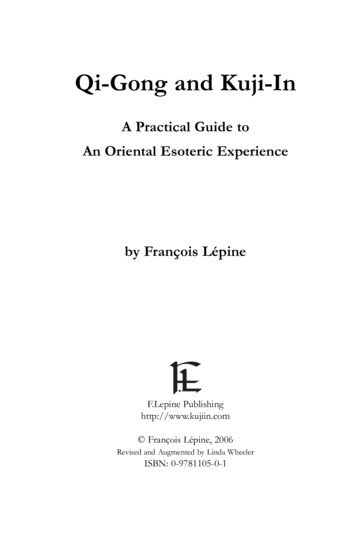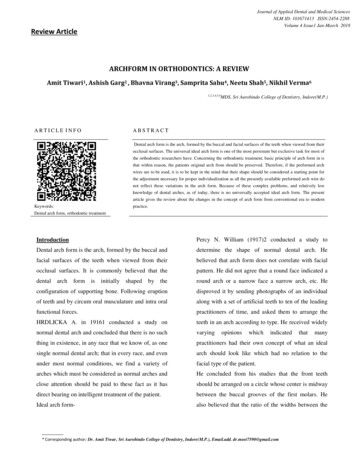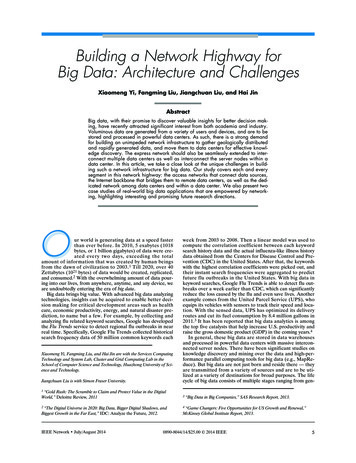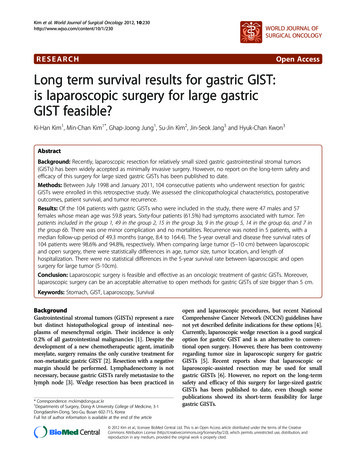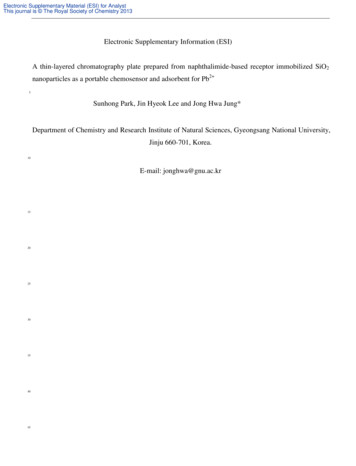
Transcription
Electronic Supplementary Material (ESI) for AnalystThis journal is The Royal Society of Chemistry 2013Electronic Supplementary Information (ESI)A thin-layered chromatography plate prepared from naphthalimide-based receptor immobilized SiO2nanoparticles as a portable chemosensor and adsorbent for Pb2 5Sunhong Park, Jin Hyeok Lee and Jong Hwa Jung*Department of Chemistry and Research Institute of Natural Sciences, Gyeongsang National University,Jinju 660-701, Korea.10E-mail: jonghwa@gnu.ac.kr15202530354045
Electronic Supplementary Material (ESI) for AnalystThis journal is The Royal Society of Chemistry 2013Experimental SectionGeneral: 1H and 13C NMR spectra were measured on a Bruker ARX 300 apparatus. IR spectra were5obtained for KBr pellets, in the range 400 - 4000cm-1, with a shimadzu FT-IR 8400S instrument, andMass spectra were obtained by a JEOL JMS-700 mass spectrometer. The optical absorption spectra ofthe samples were obtained at 278-77 K using a UV–vis spectrophotometer (Hitachi U-2900). Allfluorescence spectra were recorded in RF-5301PC spectrophotometer.10SEM observations: For transmission electron microscopy (TEM), a piece of the gel was placed on acarbon-coated copper grid (400 mesh) and removed after one min, leaving some small patches thesample on the grid. The specimens were examined with a JEOL JEM-2010 transmission electronmicroscope operating at 200 kV using an accelerating voltage of 100 kV and a 16 mm workingdistance. Scanning electron micrographs of the samples were taken with a field emission scanning15electron microscope (FE-SEM, Philips XL30 S FEG). The accelerating voltage of SEM was 5–15 kVand the emission current was 10 μA.Photophysical studies: Fluoroscence spectra of 1 (10.o mg) were observed upon addition of variousmetal ions (0-10.0 equivalents) in aqueous solution at pH 7.Preparation of compound 3. Under nitrogen, a solution of 4-bromo-1,8-naphthalic anhydride (0.6 g,202.18 mmol) compound 4 (0.7 g, 3.26 mmol) in 2-methoxyethanol (40 mL) was refluxed for 48 h, themixture was evaporated by rotary evaporation and dissolved in CH2Cl2 (150 mL). The organic layerwas washed with water (3 x 100 mL), dried over anhydrous Na2SO4, and filtered. After the solutionwas evaporated under reduced pressure, the crude product was purified by column chromatography(silica, CHCl3/EtOH 99:1) to give 0.52 g of 3 (6.7 % yield). 1H NMR (300 MHz, CDCl3, δ): 1.24 (t,256H, J 25 Hz), 2.77 (t, 2H, J 25 Hz), 2.86 (t, 2H, J 20 Hz), 4.16 (q, 2H, J 24 Hz), 6.75 (d, 1H, J 28), 7.65 (t, 1H, J 25 Hz), 8.15 (d, 1H, J 28), 8.50 (d, 1H, J 28 Hz), 8.62 (d, 2H, J 24). ESIMS (m/z) Calcd. for C22H23N1O7: 413.1. Found: 440.1 [Na(3)] . FT-IR: 3004.32, 1712.97, 1362.10,1420.66, 1221.97, 1092.20 and 901.51 cm-1. Element analysis: calculated for C22H23N1O7 : C 63.92 H5.61 N 3.39 O 27.09 Found C 64.12 H 5.87 N 3.1930Preparation of compound 2: Compound 3 (0.6 g, 1.4 mmol), was dissolved in ethanol (20 mL). Tothis was added NaOH (0.87 g, 21.7 mmol) and the resulting solution refluxed for 6 h. Progress of thishydrolysis reaction was periodically monitored by TLC. Upon complete consumption of the ester, thereaction mixture was acidified with conc. H2O and extracted with ethyl acetate. The organic layer was
Electronic Supplementary Material (ESI) for AnalystThis journal is The Royal Society of Chemistry 2013dried over Na2SO4, filtered and concentrated to dry ness to afford pure compound 2 (84.2% yield). 1HNMR (300 MHz, CDCl3, δ): 2.55 (t, 2H, J 26 Hz), 2.71 (t, 2H, J 23 Hz), 3.61 (t, 2H, J 21 Hz),4.23 (t, 2H, J 25 Hz), 6.8 (d, 1H, J 29 Hz), 7.68 (t, 1H, J 26 Hz), 8.2 (d, 1H, J 29 Hz), 8.4 (d,1H, J 25 Hz), 8.7 (d, 1H, J 28 Hz), 12.3 (s, 2H). 13C NMR (75.4 MHz, DMSO-d6): δ 173.5 173.25164.0 163.1 150.8 134.6 130.9 129.7 129.0 124.5 122.0 120.5 108.1 104.1 49.0 35.9 33.5 33.0. FT-IR :3404, 2924, 2584, 1723, 1682, 1639, 1576, 1549, 1357, 1261, 1233 and 1022 cm-1. ESI-MS (m/z)Calcd. for C18H15N1O7: 357.0. Found: 356.1 (M-). Element analysis: calculated for C18H15N1O7 : C60.51 H 4.23 N 3.92 O 31.34 Found C 60.87 H 4.51 N 4.23.Preparation of compound 1: Compound 2 (35 mg) was dissolved in anhydrous toluene (20 mL). The10silica nanoparticle (27 mg) was added as a solid. The suspension of silica was stirred under refluxcondiions for 24 h in toluene. Then, the collected solid was washed copiously with toluene (50 mL) torinse away any surplus 2 and dried under vacuum. FT-IR : 3404, 2924, 2584, 1723, 1682, 1639, 1576,1549, 1357, 1261, 1233 and 1022 cm 1
Electronic Supplementary Material (ESI) for AnalystThis journal is The Royal Society of Chemistry 2013Scheme S1. Preparation Method of 2-immobilized SiO2 nanoparticle (1).51015
Electronic Supplementary Material (ESI) for AnalystThis journal is The Royal Society of Chemistry 201351015Fig. S1 FT-IR spectra of (a) 2, (b) mesoporous silica and (c) 1.
Electronic Supplementary Material (ESI) for AnalystThis journal is The Royal Society of Chemistry 2013Fig. S2 TOF-SIMS spectrum of 1.5
Electronic Supplementary Material (ESI) for AnalystThis journal is The Royal Society of Chemistry 201351015Fig. S3 Time course of the fluorescence intensity of 1 (10.0 mg) upon addition of Pb2 (10.0 equiv) in20aqueous solution at pH 7; a) 0 min, (b) 0.5 min, (c) 1 min, (d) 2 min, (e) 3 min, (f) 4 min, (g) 5 min, (h)6 min, (i) 7 min and (j) 8 min2530Fig. S4 Fluorescence intensity of 1 (10.0 mg) with Pb2 (10.0 equiv) in the presence of other metal35ions such as Cu2 , Ca2 , Cd2 , Co2 , Hg2 , Fe2 , Na2 , Ni2 , Zn2 and Mg2 ions in water at pH 7.
Electronic Supplementary Material (ESI) for AnalystThis journal is The Royal Society of Chemistry 201351015Fig. S5 Fluorescence intensity of 1 (10.0 mg) before and after addition of metal ions (5.0 equivalents)at different pH values.
Experimental Section General: 1H and 13C NMR spectra were measured on a Bruker ARX 300 apparatus.IR spectra were obtained for KBr pellets, in the range 400 - 4000cm-1, with a shimadzu FT-IR 8400S instrument, and 5 Mass spectra were obtained by a JEOL JMS-700 mass spectrometer.
